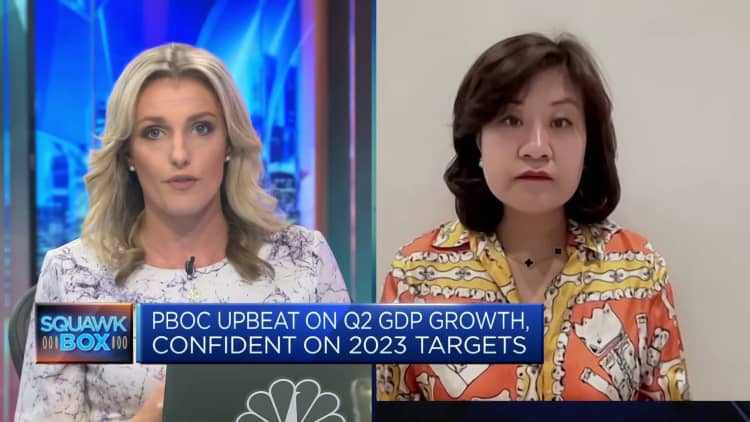Shanghai, China – November 4, 2022: Buildings in the Lujiazui financial district are illuminated to celebrate the opening ceremony of the fifth China International Import Expo (CIIE) on November 4, 2022 in Shanghai, China.
Video | Visual China Group | Getty Images
Economists see this week’s central bank action in Beijing as the starting gun for a new era of monetary policy as China’s Covid-19 reopening fails to pick up pace.
On Tuesday, the People’s Bank of China cut its seven-day reverse repurchase rate to 1.9% from 2% – the first cut in nine months – as the economy lost momentum and hard data began to disappoint. Top China economists at Wall Street banks see the move as the start of more policy easing to come.
“This is the first rate cut since August 2022, further confirming that policymakers have shifted from wait-and-see to active easing,” Citi economists led by Xiang Rongyu said in a research note on Tuesday, after the People’s Bank of China announced the move. Soon after the news.
“Our argument for timely easing is playing out, and more small steps without high thresholds are likely to be taken in the coming weeks,” they said, adding that the upcoming Politburo meeting in Beijing in July will be closely watched to determine Take more important steps to take.
Chinese sovereign bond prices rose following the central bank’s latest moves, while RMB fell to its lowest level since November.

Citi economists pointed to weak economic data from China, including credit data, saying “stimulus appears to be on the way, data is weak.”
China’s new bank loans rose 11.4% to 1.36 trillion yuan ($190 billion) in May, less than Reuters survey And strengthened the case for further stimulus as the economy continues to see weak demand and falling exports lead to a decline in industrial profits.
Barclays economists forecast in a report on Tuesday titled “Entering a Rate Cut Cycle” that China will cut rates every quarter through early 2024. The bank expects to cut its mid-term lending rate by 10 basis points on Thursday, as well as cut its lending prime rate (two monetary levers used by the PBOC) next week.
“Over the next nine months, based on our economic analysis and reasoning, we now expect the central bank to continue its monetary easing cycle with a further 30 basis point reduction in policy rates, a 50 basis point cut in reserve requirement ratios, and mortgage rate 60-80 basis points cut for new and existing housing loans,” Barclays economists led by Jian Chang said in a note.
Goldman economists including Hui Shan said the firm expects the central bank to cut the medium-term lending facility rate on Thursday and cut the prime lending rate by 10 basis points next week. The People’s Bank of China controls benchmark one-year lending and deposit rates, which affect borrowing costs for banks, businesses and individuals across the country.
Economists at Goldman Sachs expect a cut in the RRR across the board in the third quarter of this year, given that the People’s Bank of China has never cut its policy rate and RRR in the same month. The reserve requirement ratio refers to the amount of money a bank must hold in its vaults as a proportion of its total deposits.
Goldman also expects the People’s Bank of China to cut its reserve requirement ratio by another 25 basis points in the third quarter of this year, their economists said, adding that the firm expects another cut in the final quarter as well.
“Sluggish activity growth, potentially weak credit extensions and subdued confidence are reasons for the cut in our view,” they said.
Is it enough?
Vishnu Varathan, head of Asia economics and strategy at Mizuho Bank, argued that the PBoC’s latest actions “haven’t worked”.
“Markets have reason to be unmoved as credit data details point to a worrying lack of confidence in the private sector, which could undercut the usual stimulus,” he said.
He predicts that a more substantial plan will be necessary – at the risk of overadjusting and compromising economic stability.

“Apart from a more comprehensive stimulus program that could endanger financial stability, it looks like a rate cut by the PBoC may not cut it,” Varathan said.
Economists at Societe Generale also said that “more easing is needed, especially fiscal policy backed by central government money.”
“However, the trickle-down easing model preferred by Chinese policymakers may not be well suited to contain the mounting pressure to deleverage in the economy,” Societe Generale economists said.


